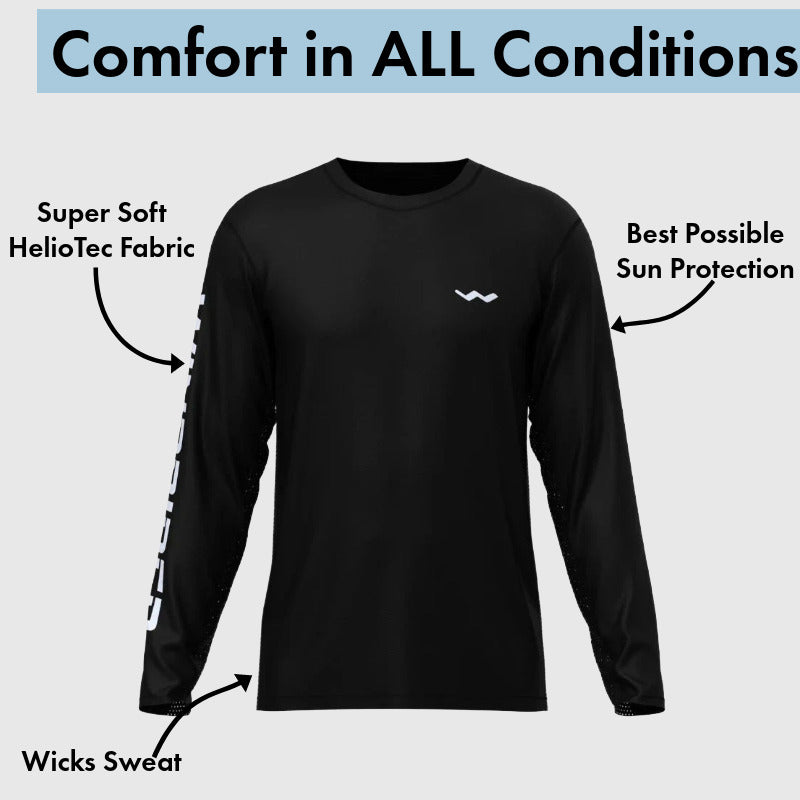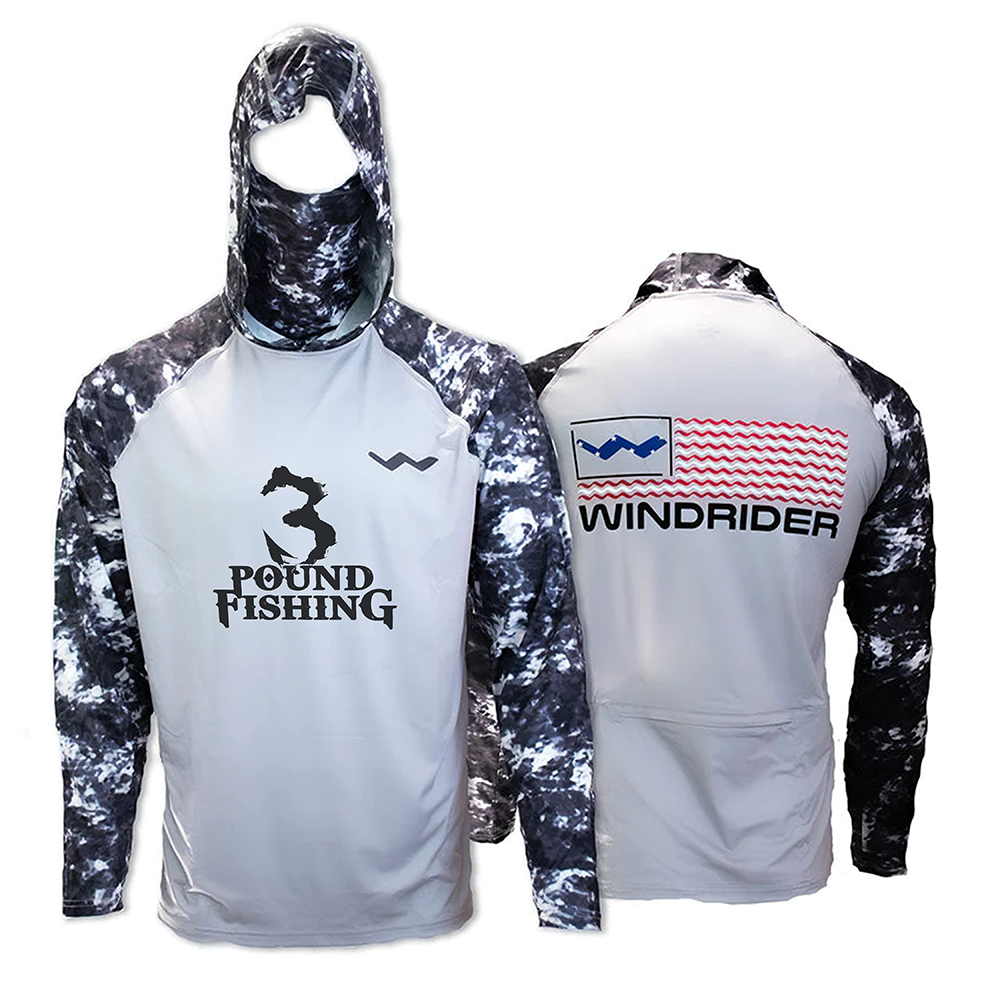Understanding the Science of Fishing Shirt Odor
Cotton and its blended fabrics, with their natural cellulose weave, double as bacterial incubators. The fibers soak up moisture like reservoirs and hold it against skin, keeping things damp for surprisingly long periods. That lingering warmth—85-95°F—paired with moisture gives germs a perfect environment to explode in numbers. In ideal conditions, a single bacterium can multiply to about 8 million within just 24 hours.
Cotton doesn't merely soak up water—it actually traps the organic compounds that bacteria feast on. When you sweat, the amino acids, fatty acids, and other organic molecules in perspiration seep into cotton fibers, lingering there as food for microbes even after fabric feels completely dry.
Technical synthetic fabrics operate differently. Polyester and nylon are hydrophobic—they push water away instead of soaking it up. When you sweat in a performance fishing shirt, moisture is drawn through the fabric by capillary action and evaporates quickly rather than lingering trapped.
How Moisture-Wicking Controls Bacterial Growth

Moisture-wicking is the first line of defense against odor-generating bacteria. It operates through purpose-engineered fabric structures that create channels guiding liquid away from skin and allowing it to spread across the garment's outer surface.
When sweat contacts the inner layer of a quality fishing shirt, it's quickly drawn outward through a maze of microscopic channels woven between polyester fibers. That wicking action distributes dampness over a larger area, letting any airflow speed up evaporation.
When Helios fabric gets drenched, it sheds water in 12-15 minutes under moderate conditions—about 80°F, 50% humidity with light breeze. Cotton by contrast clings to moisture for 45-60 minutes. That rapid-dry advantage is why synthetic shirts tend to stay odor-free: bacteria barely have a window to establish before dampness vanishes.
Rapid drying does more than keep you dry—it also eliminates bacteria. Odor-producing microbes need damp environments to survive. When fishing shirt fabric dries quickly and thoroughly, bacterial populations shrink as cells dry out. The culprits behind that "old shirt" smell just can't endure the pattern of brief moisture followed by swift drying.
How Fish Slime Damages Cotton but Spares Synthetic Materials
Anyone who's spent a day on water in a cotton shirt knows the problem: a single brush with a slick, mucus-laden fish can embed a fishy odor that no amount of laundering fully banishes. The organic compounds in fish slime seep into cotton fibers, lingering there as an endless buffet for bacterial growth.
Fish slime is packed with proteins, glycoproteins, and mucopolysaccharides—organic compounds that bacteria thrive on. When those compounds seep into cotton's weave, they embed themselves within cellulose fibers at a molecular level. Even vigorous washing only strips away the surface layer, leaving hidden organic residue that continues to feed bacterial growth wash after wash.
Non-absorbent by design, synthetic fishing shirt fabrics dodge the issue outright. Fish slime, blood, and other organic residue simply coat the polyester or nylon filaments instead of being absorbed. A brisk rinse with water sweeps away most grime, and a standard machine wash clears the remainder completely.
That's why seasoned guides and charter captains who haul in hundreds of fish weekly stick exclusively to technical fishing shirts. Cotton shirts pick up lingering odor after just a few hard-fought days, while quality synthetics keep you feeling fresh for an entire season of relentless use.
Saltwater's Subtle Influence on Odor Development
Saltwater fishing adds odor challenges that exceed those found in freshwater settings. After fabric dries, salt crystals remaining in it draw moisture from air via hygroscopy, keeping material perpetually damp even when it feels dry. This ongoing low-level moisture provides bacteria with the water they need to survive and multiply.
Salt tends to irritate skin, which in turn increases both sweat and oil output—essentially feeding the bacteria that produce odor. Meanwhile, salty water usually harbors higher bacterial loads than fresh water, meaning it can deposit fresh microbial colonies onto clothing.
High-performance fishing shirts tackle those challenges by using designs that make rinsing easy and drying instantaneous. After a stint in saltwater, a quick rinse with fresh water washes salt crystals before they can lodge into fabric. Rapid-dry technology then pulls remaining moisture out, preventing bacterial colonies from gaining foothold.
Seasoned saltwater anglers note that UPF 50+ fishing shirts, when properly cared for—rinsed after each use and washed regularly—remain fresh for 150-200 fishing days before any persistent odor starts to show.
Browse our rain protection gear for more options.
What Makes Multi-Day Wear Possible

One handy benefit of odor-resistant fishing shirts is that they can be worn for several days straight without needing a wash. That proves crucial on fishing trips where access to laundry is scarce or simply absent.
Cotton shirts become unwearable after one grueling sun-blasted day of fishing. Sweat, fish slime, and burgeoning bacteria fuse into an odor that's downright offensive and a comfort level that plummets. As a result, you need a fresh cotton shirt every day, which consumes surprising luggage space on week-long outings.
Technical fishing shirts stay fresh and comfortable when worn 2-3 days in a row under hot fishing conditions. The routine is simple: spend the day on water in the shirt, then give it a rinse in fresh water at day's end to wash away salt and surface grime. Hang it up to dry—usually fully dry within 1-2 hours—and slip it on again the next morning.
Because it can be worn for days, required gear for remote fishing trips drops from seven shirts per week to just 2-3, dramatically simplifying packing and logistics.
Antimicrobial Treatments: Necessary or Marketing Spin?
Some fishing shirts feature antimicrobial treatments—chemical applications that directly kill bacteria rather than merely making the environment hostile. Common agents are silver ions, zinc compounds, and quaternary ammonium substances embedded in fabric.
During the first 20-30 washes, these treatments really enhance odor defense. Yet with each wash, antimicrobial chemicals gradually leach away, causing protection to fade. In practice, most treatments retain antimicrobial advantages for about 40-60 washes before leveling off to ordinary levels.
One must ask whether antimicrobial treatments are even necessary when underlying fabric already curtails odor through moisture-wicking and rapid-drying traits. Most anglers find that well-engineered synthetic weaves supply ample odor resistance, making chemical antimicrobials unnecessary. Mechanical characteristics—quick drying, non-absorbent fibers—bestow sufficient bacterial deterrence to keep garments feeling fresh.
Nonetheless, for anglers working in moisture-laden tropical environments, those whose physiology tends toward pronounced body scent, or fishermen forced to wear the same shirt for 4-5 consecutive days, antimicrobial treatments can be a genuine benefit. The chemical barrier adds a layer of odor-defying protection when conditions push limits.
Maintaining Long-Term Odor Resistance
Even diligent odor-blocking fishing shirts will eventually pick up lingering smells if they aren't cared for correctly. Given time and right circumstances, bacteria can take hold in any fabric. Consistent proper maintenance stops that progression in its tracks.
- Rinse after every saltwater use: A fresh-water rinse within a few hours after fishing flushes out lingering salt, fish slime, and surface microbes before they can seep into fabric or take root. That single habit slashes 80% of persistent long-term odor issues.
- Machine wash regularly: Washing after 3-5 wears helps sweep away buildup of oil, flaked skin, and other organic remnants. Stick with cold water and gentle soap; hot water or harsh cleaners can compromise moisture-wicking capability.
- Avoid fabric softeners: When softener blankets cloth with wax-like sheen, it smothers capillaries that pull moisture away. That clog tends to stick, essentially erasing the shirt's built-in odor-fighting edge.
- Air dry when possible: When feasible, let the fishing shirt dry in air. Although quality shirts can survive low-heat tumbles, hanging them out stretches their lifespan and preserves peak performance.
- Address odor promptly: If a shirt starts to smell despite proper care, deal with it before scent sets in. Soak the garment in a mixture of vinegar and water (one part vinegar to four parts water) for about 30 minutes, then run it through a normal wash.
The Cost-Benefit Analysis of Technical Fabrics
Odor-blocking fishing shirts typically carry price tags of $50-90, while cotton counterparts sit at $15-25. That sizable price disparity inevitably prompts questions about whether extra cost delivers commensurate value.
Looking at economics in practice, a cotton fishing shirt usually endures 15-20 days on water before odor becomes impossible to manage, even after washing. A high-quality synthetic shirt by contrast stays fresh for 150-200 days. That translates to 10 times the usable life, making the synthetic option roughly 4-5 times more cost-effective despite its higher upfront price.
Factoring in washing frequency—extending garment life and cutting water and energy expenses—plus elimination of fabric softener purchases and ease of wearing the same outfit over several days on fishing trips, the value proposition becomes even more compelling.
For anglers who only cast a line 10-15 days yearly, a cheap cotton shirt will usually suffice. But for dedicated fishermen who spend 50 or more days on water, investing in an odor-resistant technical fishing shirt turns out to be both financially savvy and practically sound.

